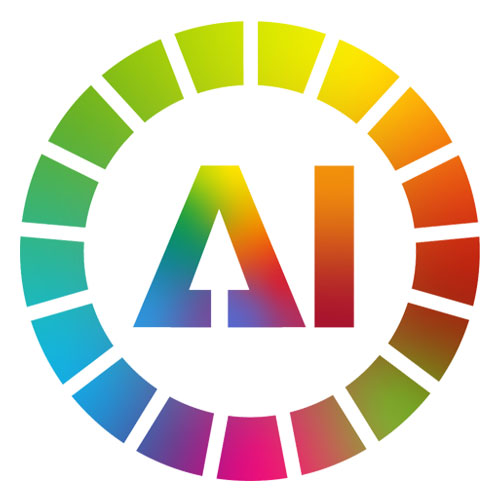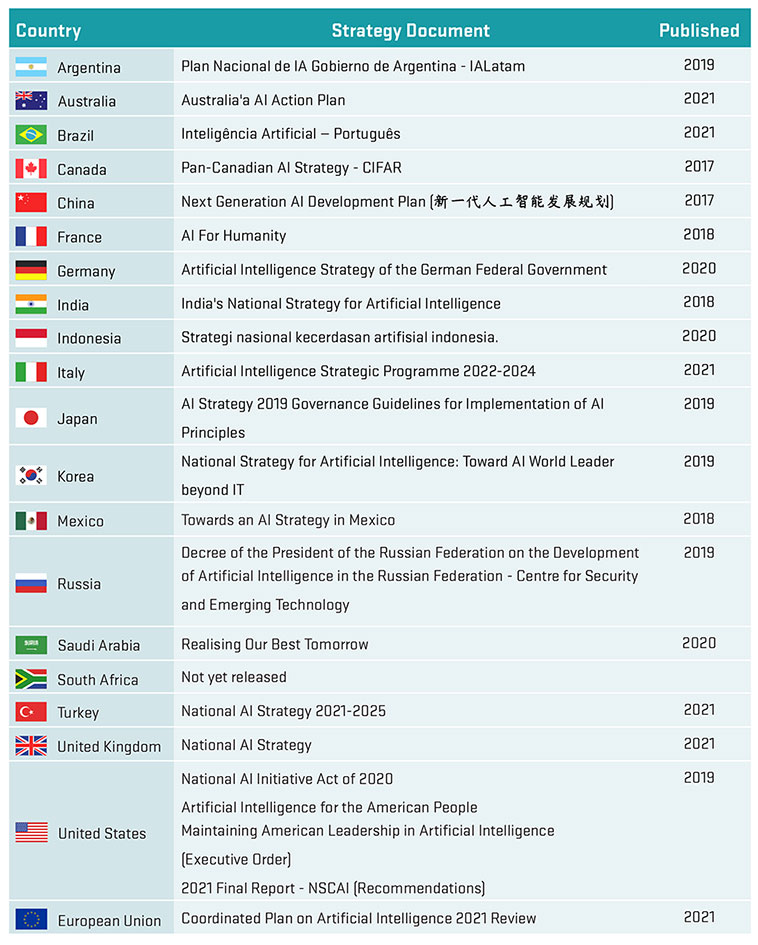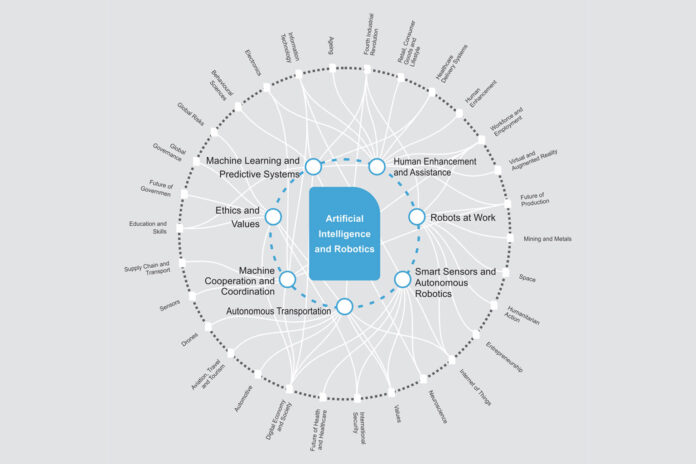Something is happening to our world, everything is changing. Digitalization is permeating societies around the world, with our bodies becoming so high-tech that the difference between what is artificial and what is human slowly disappearing.
In the age of Metaverse, augmented reality, virtual reality, 3D Printing and genetic editing, the 4th Industrial Revolution (4IR) is transforming all aspects of human life, work and play. Artificial Intelligence (AI), the leading technology of the 4th Industrial revolution, captures this transition and has grabbed worldwide public attention. It has become the symbol of the 4IR, generating immense global debate, scrutiny and innovation at the same time.
Today AI is making headlines on a daily basis — and the headlines are not always positive. Technology leaders and experts are warning about the potential dangers of AI, from the development and use of autonomous lethal weapons, to turbocharging misinformation and disinformation that undermine democratic norms and institutions. As AI begins to impact societal functions at an unprecedented scale, it is a technology that is both inspiring and misrepresented in public discourse. The visual sights of machines learning and preforming human functions, such as self-driving cars, humanoid robots etc. scare a lot of people. It raises fears and concerns about machine autonomy, trustworthiness and the future of humanity.
This article sets out to map how major countries and institutions such as the UN System and G20 Countries are dealing with fast paced developments in AI, operating in the vacuum of a global governance architecture on artificial intelligence; so that the technology and the change it brings can be better understood.
UNITED NATIONS : CORE PRINCIPLES & VALUES OF AI
The United Nations, which is the world’s foremost intergovernmental organization has taken the lead in discussing, debating and formulating a global governance architecture on AI. The United Nations and its specialized agencies such as UNESCO (the United Nations Educational, Scientific and Cultural Organization), ITU (International Telecommunication Union) and others have formulated Core Ethical Principles of AI after undertaking years of extensive research, data collection and expert views onboard. These ‘Core Principles’ of AI are –
1. Respect for Human Rights and fundamental freedoms of human dignity
2. Proportionality and Do No Harm
3. Adherence to User Safety, Security and Trustworthi- ness
4. Promoting Peace
5. Contributing to achieving the Sustainable Develop- ment Goals (SDGs)
This means that the UN advocates that any AI platform, application, technology or creation of such must adhere to these core principles in order to ensure ethical and beneficial use of artificial intelligence for all of humanity. These same principles have been the basis of the UN Inter-Agency Working Group on Artificial Intelligence. Moreover, on 26 October 2023, the United Nations Secretary General, Antonio Guterres has announced the creation of a new Artificial Intelligence Advisory Board that will focus on the risks, opportunities and international governance of AI using the Core Principles.
The AI Core Principles also underscore Values of AI, values that the UN says must drive the advancements and underpin the revolutionary technology. These underlying values are: Safety and Security, Trustworthiness, Human oversight and determination, Responsibility and accountability, Right to Privacy and data protection, Fairness and non-discrimination, Transparency and explainability and Multi-stakeholder adaptive governance and collaboration.
In public discourse, the values of trustworthiness, human oversight and explainability are of particular significance and grab the highest attention, as AI enters households and workplaces on a global scale. For AI to be trustworthy, it is an essential requirement that the AI systems are subject to thorough monitoring by relevant stakeholders and entities throughout the life cycle of the technology. Human oversight of AI is meant to ensure that the technology does not ‘get out of control’ and there is always a human involved in the decision cycle of AI Systems. Explainability means that the common person who interacts with the AI systems understands what is happening, how the technology works and what are their choices when interacting with AI. It also means that the developers of AI systems, the engineers and coders themselves understand what they have created in AI applications and how the AI system may evolve in the future, so that they can put in the necessary guardrails as needed.
There is also much concern that as artificial intelligence evolves, its systems and applications can get so complicated that only a select handful of ‘geniuses’ in the world understand the complex algorithms that drive the AI. For instance, today the mathematics and algorithms that drive and control stock markets are so complex that the majority of the global public does not know or understand how Stock Markets function, even though the stock markets play a critical role in the financial fortunes of nations, societies and individuals. If a similar trajectory of advancement was followed with AI systems, there is a huge risk that the technology can ‘grow out of the control.’
To discuss this and other pertinent applications and questions surrounding the technology, the United Nations through its specialized agency the ITU organized a special AI Summit in Geneva, Switzerland earlier this year.
AI FOR GOOD GLOBAL SUMMIT

The International Telecommunication Union (ITU) organized the AI for Good Global Summit in Geneva on 6-7 July 2023. The Summit is the Leading action-oriented United Nations platform promoting artificial intelligence to advance health, climate, gender, inclusive prosperity, sustainable infrastructure and other global development priorities. It is the world’s pre-eminent AI Summit where debate, critique and advancements in AI take center-stage and is a melting point for industry, private actors, academia and government entities to collaborate, partner and compare progress on artificial intelligence.
The ITU, which is the UN specialized agency for information and communication technology, led the Summit in partnership with 40 UN sister agencies, which made the Summit the ideal platform molding global governance in AI through practical applications.
With its focus on finding practical ways to use artificial intelligence to address global problems and map out policies to regulate it, the Summit encourages development and deployment of AI technologies that align with the United Nations Sustainable Development Goals (SDGs) and promotes the concept of using AI for positive impact. It also deliberates on the need for robust governance frameworks to guide the development, deployment, and regulation of AI technologies. It aims to inspire participants to explore innovative AI solutions that can contribute to a more inclusive, sustainable, and equitable future.
This correspondent had the opportunity to attend the Summit in person and witness first hand the cutting edge of AI, be it humanoid robots like Sophia and Ameca, who are the most advanced human-like robots on the planet; participate in a press conference led by a panel of AI robots who answered questions live in the press conference; and witness AI making complex decisions in healthcare and produce original creative music.
As the UN, through initiatives like the AI for Good Summit, develops a global governance architecture on artificial intelligence, nation states too are not far behind, particularly the powerful G20 countries who are driving the global economy and leading the 4th Industrial Revolution.
G20 COUNTRIES’ NATIONAL AI STRATEGIES

More than 60 countries have declared National AI strategies in the last 5 years alone, showing the growing attention and seriousness with which governments around the world are approaching artificial intelligence. Amongst these 60 nations, the G20 countries dominate the global conversations, innovations and advancements in artificial intelligence.
The G20 countries each have their own set of National AI Strategies, but an analysis of these different strategic policies shows certain common AI principles and goals that can form the basis of a future global AI governance architecture in conjunction with the United Nations and its new Artificial Intelligence Advisory Board, which will focus on the risks, opportunities and international governance of artificial intelligence.
The national AI strategies of the G20 countries can be summarized as:
Argentina
Argentina has set out ambitious goals for a digital future. The country’s AI strategy imagines a much more commercially focused approach, which aims to maximize the potential of AI to contribute towards economic growth. It envisions that AI inclusive developments will improve people’s quality of life. It also wants to minimise the risks associated with AI in terms of data protection and privacy and develop AI talent and R&D, through improved collaboration with the industry partners.
Australia
Australia’s AI Action Plan sets out a strategic vision to establish Australia as a global leader in developing and adopting trusted, secure and responsible AI. The Action Plan has 4 focus areas: (1) Developing and adopting AI to transform Australian businesses, (2) Creating an environment to grow and attract the world’s best AI talent, (3) Using cutting edge AI technologies to solve Australia’s national challenges (4) Making Australia a global leader in responsible and inclusive AI.
Brazil
Brazil is the only developing country within the G20 that has proposed a legal framework for AI to reduce the use of abusive, illicit or discriminatory practices across public and private sectors and to protect fundamental rights. The country’s regulatory objectives also include promoting competitiveness in the industry, re-skilling the workforce, and stimulating improvement of public service delivery using AI. This strategy is aimed at strengthening AI research and Development along with ethical deployment of the technology to address the Brazil’s social and development challenges.
Canada
Canada was the first country to release a national AI strategy in 2017. This strategy has three pillars: (1) Commercialization (2) Standards (3) Talent and Research; which bring together partners from across Canada. The country takes pride in its research muscle and wants to enhance it’s visibility in AI research and training generating world class innovation; increasing collaboration and innovation across sectors; attracting and retaining AI talent; and translating AI research discoveries into applications for the public good.
China
The triumph of Google Deep Mind’s AI computer program AlphaGo over Lee Sedol, the world’s top professional Go player in 2016 was China’s “sputnik moment” in its AI journey. This triumph by Western technology firms in one of the most respected Chinese games brought a radical change in China’s approach towards artificial intelligence. Today China has become an AI Superpower and a formidable counterweight to the USA when it comes to building advanced AI Systems. China aims to become the world’s ‘major AI innovation centre’ by 2030 and plans to expand AI in many spheres of production, governance and defence. The country ranks second globally in AI and hopes to acquire ‘leapfrog’ technologies, including in military AI.
France
France’s ambitious artificial intelligence policy: AI for Humanity, is built on three objectives – (1) to achieve the highest scientific level in AI by training and attracting the best global talent; (2) wide-spread use of artificial intelligence in the economy and society, notably through startups, public-private partnerships and data sharing; (3) to give AI an ethical frame. Moreover the country believes it has sufficient maturity to launch “major AI transformation operations” in health, transport, environment, and defence and security.
Germany
Germany is a leading destination for AI related research and development. In fact, it is home to the famous Cyber Valley, which happens to be Europe’s largest consortium for research and innovation in machine learning and related fields. The main focus areas of the country’s AI strategy are (1) Research, (2) Transfer (3) Industry 4.0 (4) Mobility (5) Healthcare and long-term care (6) Environmental and climate protection and (7) Regulatory framework for the humancentric use of AI at work and in society.
India
India finds itself uniquely placed as a strategic partner for like-minded democracies looking for alternative economic and political partners to China. India is strategically positioning itself as the “tech garage” of the world and building an AI startup ecosystem, leveraging the country’s legacy as a pioneer in information technology services. Today India has already built the world’s largest and low cost Digital Public Infrastructure (DPG) that is digitalizing the world’s most populous nation and society at an unprecedented scale. The priority sectors of India’s AI strategy are (1) Agriculture; (2) Healthcare; (3) Smart cities and infra- structure; (4) Education; and (5) Smart Mobility. India is poised to launch its highly anticipated National Programme on AI (NPAI) soon.
Indonesia
The country’s strategic position at the heart of the Indo-Pacific and maritime trade routes has attracted the attention of the big AI economies like the US, Japan, China, and South Korea, who are pouring in significant investments in Indonesia’s technology start-ups, and cyber security. From the US’s ‘Pivot to Asia’ and China’s Belt and Road Initiative, this South East Asian country could potentially tilt the balance of power in favor of any country it chooses to side with. But Indonesia is cautiously treading the path of diplomatic balance. This path of “neutrality” is reflected in Indonesia’s National AI Strategy, which has four key focus areas of: (1) Talent development; (2) Data infrastructure; (3) Industrial research; (4) In- novation with ethics and policy.
Italy
The Italian strategy highlights an ethical regulatory framework for AI which must ensure transparency, accountability and reliability in order to stimulate citizens’ trust and engagement in a thriving AI ecosystem. It provides a long-term vision for sustainable development of AI with focus on: (1) Improving AI education at all levels, (2) Fostering AI research and innovation, (3) Establishing an ethical regulatory framework for a sustainable and trustworthy AI, (4) Supporting international networks and partnerships, (5) Developing a data infrastructure for AI applications and (6) Improving public services through a wider adoption and use of AI systems.
Japan
Japan’s basic values on AI are aligned with those of the Organisation for Economic Co-operation and Development (OECD) countries. The country has determined three social principles of human-centric AI: dignity, diversity and inclusion, and sustainability. The country’s AI strategy highlights Japan’s trust that AI will define technology competitiveness and economic power, and that it can improve the quality of life and enable new kinds of mobility. At the same time, Japan is not agreeable to mass surveillance. As such, its strategy confronts a fundamental issue—how to maximise the benefits of AI and minimise the risks. The four strategic visions of its AI strategy are (1) Human resources; (2) Develop and deployment to the real world; (3) Technologies for inclusion: and (4) International cooperation. The AI strategy identifies the Global Partnership on AI (GPAI OECD) as a practical international framework initiative to align with global standards for AI and data governance. Japan is working with Australia, India, and the United States to promote the use of AI in line with democratic norms and values.
Korea
South Korea has made remarkable progress in building a stable foundation to capitalise on AI with investments in its technological infrastructure, ICT and 5G technology, innovations, and skill base. Its strategy has the central objective of enhancing AI Research & Development by securing AI talent through scholarships, trainings, and research institutes; increasing AI development in medicine, national defence, and public safety; and investing in infrastructural support for SMEs, such as AI startup incubators and semi-conductor support.
Mexico
Mexico was the first country in Latin America to produce an AI strategy. This strategy has five focus areas: (1) Governance, government, and public services, (2) Research and development, (3) Capacity, skills, and education, (4) Data infrastructure and (5) Ethics and regulation. Mexico has a multisectoral coalition called IA2030Mx, comprised of academia, startups, and pub- lic agencies, that has taken charge on AI adoption and policymaking in Mexico with the philosophy of “co-responsibility”. The coalition is encouraging academic institutions, enterprises, public agencies, professionals along with other significant actors in the digital ecosystem to participate in the creation of a National AI Agenda 2030 and the promotion of OECD AI principles to ensure Mexico does not lag behind in the 4IR.
Russia
Russian President Vladimir Putin had famously stated, “Whoever becomes the leader in the AI sphere will become the ruler of the world. Since that time Russia has bet heavily on automation in the battlefield. But curiously its national AI strategy has no direct mention of AI for national defence. The strategy highlights basic principles to guide Russia’s development of AI such as (1) Protection of human rights, (2) Security, (3) Transparency, (4) Technological sovereignty, (5) Innovation cycle integrity, (6) Cost-effectiveness, and (7) Support for competition. The strategy envisions that over the next 10 years, Russia will ramp up scientific research and development efforts, investing in software and hardware, and improving the availability and quality of data for AI technologies. Additionally, Russia seeks to educate, retain, and attract top quality AI talent while creating a favorable and flexible regulatory environment that will stimulate investment, research, development, testing, and integration of AI-based technologies and solutions into various sectors of the Russian economy and society. The strategy also identifies ‘access to the high-quality data needed to develop AI technologies’ as one of its main priorities.
Saudi Arabia
By granting complete citizenship and legal personhood to an AI humanoid robot named Sophia in 2017, Saudi Arabia leapfrogged the process of embracing AI. Its flagship national mission, “Saudi Vision 2030” – has data and AI at its core. The Vision document sets the goal for the next 15 years by building on three pillars: (1) An ambitious nation, (2) A vibrant society, and (3) A thriving economy using technology. Saudi Arabia is also working on the NEOM city project, which is set to integrate AI and robotics in all aspects of the city, such as healthcare and education. The country also plans on becoming the world leader for AI events and conferences, attracting global AI specialization to the Kingdom.
South Africa
South Africa has yet to release an AI strategy.
Turkey
Turkey is leading in the adoption and export of military applications of unmanned aerial vehicles. Advanced Turkish drones have changed the battlespace of the Russia-Ukraine war in real-time. Even with staggering inflation, the country is witnessing an increase in exports and the indigenisation of AI technology. Its national AI strategy plans to focus on six strategic priorities – (1) Educating citizens in AI, (2) Supporting research activities; (3) Entrepreneurship and innovation in the field of AI; (4) Developing access to quality data and technical infrastructure; (5) Making arrangements to “accelerate socioeconomic adjustment;” (6) Improving international cooperation and accelerating structural and workforce transformation.
United Kingdom
Britain has a 10-year plan to become a global AI superpower. Its AI strategy has 3 main objectives – (1) Invest and plan for the long-term needs of the AI ecosystem to continue British leadership as a science and AI superpower; (2) Support the transition to an AI-enabled economy, capturing the benefits of innovation in the UK, and ensuring AI benefits all sectors and regions; (3) Ensure the UK gets the national and international governance of AI technologies right to encourage innovation, investment, and protect the public and British fundamental values. It plans to achieve these stated aims through broad public trust and support, and by the involvement of the diverse talents and views of the British society.
United States
“America is not prepared to defend or compete in the AI era. This is the tough reality we must face. And it is this reality that demands comprehensive, whole-of-nation action,” declared the US National Security Commission on Artificial Intelligence (NSCAI) in its final report presented to the US president and Congress in 2021. As the world’s foremost AI Superpower with the broadest AI technology, infrastructure and talent; America is focused on maintaining its AI leadership vis-à-vis China and it is the stated policy of the US that continued American leadership in AI is of paramount importance to maintaining the economic and national security of the country. The US also prioritises a “principled and coordinated approach to international collaboration in AI research. It wants to make long-term investments in fundamental and responsible AI research, underscoring a commitment to the ethical and responsible development of AI. The US AI strategy broadly focuses on – (1) Creating effective methods for human-AI collaboration; (2) Addressing the ethical, legal, and societal implications of AI; (3) Ensuring AI systems’ safety and security; (4) Developing shared public datasets and AI training and testing environments; (5) Establishing standards and benchmarks for AI system evaluation. (6) Understanding the national AI R&D work-force needs and (7) Expanding public-private partnerships to speed up AI advances.
European Union
Ursula von der Leyen, President of the European Commission has stated that “We [EU] will be particularly careful where essential human rights and interests are at stake. Artificial intelligence must serve people, and therefore artificial intelligence must always comply with people’s rights.” The EU is in the process of negotiation and approving the EU AI ACT – its most ambitious law regulating artificial intelligence, which will become the world’s first comprehensive AI Law; setting a new global standard for AI oversight. The European Union aims to create a set of rules on AI that are ‘human centric’ which protect technology without stifling innovation. Importantly, the EU is pushing for a non-China, non-US way to approach AI.
The European Parliament’s priority is to make sure that AI systems used in the EU are safe, transparent, traceable, non-discriminatory and environmentally friendly. Their principled belief is that AI systems should be overseen by people, rather than by automation, to prevent harmful outcomes. The EU Parliament also wants to establish a technology-neutral, uniform definition for AI that could be applied to future AI systems. The AI Act proposes different rules for different risk levels of AI Systems. It categorizes AI technologies into 4 particular categories – (1) Unacceptable risk (2) High risk (3) Generative AI and (4) Limited risk–planning to govern them accordingly.
Taken together, all these different national strategies have many elements in common, which can be broadly categorized as Human Rights based, Responsible Innovation, User safety and AI for economy. These elements combined with the Core Principles of AI enunciated by the UN offer a foundation for setting up a global AI governance architecture on artificial intelligence.
GLOBAL AI GOVERNANCE ARCHITECTURE
In all likelihood, the European Union will become the first entity to implement a global AI law, and set AI standards worldwide, just as with the GDPR Act (General Data Protection Regulation). There is also much hope that the UN System can formulate a comprehensive AI legal frame- work which can be adopted by all member states, much like UNESCO’s Ethics of Artificial Intelligence, principles and values of AI mentioned previously.
The national AI strategies of G20 countries can act as foundational documents in this regard, providing a roadmap of what the common agreed upon AI governance norms are amongst the world’s most powerful nations, and where the divergences on lie. As artificial intelligence rapidly advances, the World Economic Forum has estimated that AI could contribute more than $15 trillion dollars to the global economy by 2030, with every country wanting a share of this pie. Thus as the opportunities and accompanying debate on AI intensifies with time, the fundamental question looms large in front of countries, the UN System and global AI leaders – how much automation is politically and economically sustainable?
For as Alan Turing had famously said, “If a machine is expected to be infallible, it cannot also be intelligent.”










